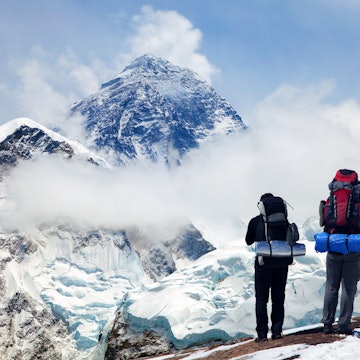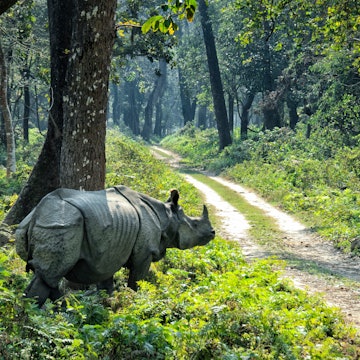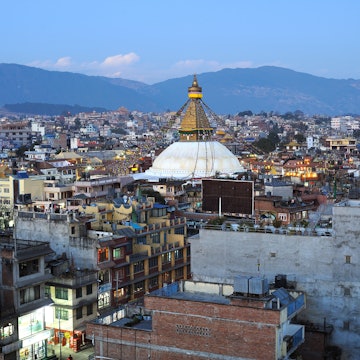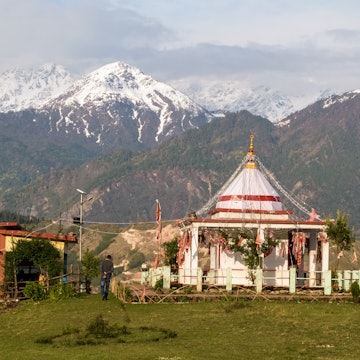

Khumbu Glacier on the way to Mt Everest base camp. CravenA/Shutterstock
Few experiences are as humbling as standing at the foot of the world’s tallest mountain. On the border between Tibet and Nepal, Mt Everest – known as Sagarmatha in Nepali and Chomolangma (or Qomolangma) in the Sherpa or Tibetan language – tops out at nearly 9km (5.5 miles). After at least a week of trekking to reach Everest Base Camp, with the prospect of more hiking days still ahead as you descend, you'll find the sight of this mighty mountain surrounded by its high-altitude friends as emotional as it is beautiful.
This trek takes a lot of effort, some expense and a solid two-week time commitment, but the combination of Tibetan-influenced Sherpa culture, good trekking infrastructure and mountain scenery grander than anywhere else on earth makes this an unmissable trail.
Here's what you need to know about hiking to Everest Base Camp in Nepal.

Why trek to Everest Base Camp in Nepal?
Mt Everest straddles the Nepal-Tibet border, but when people talk about trekking to Everest Base Camp, they almost always mean the route in Nepal. As well as having excellent infrastructure for trekkers, Nepal is more open and accessible to tourists, and from this side, the only way to reach Base Camp is on foot (or by helicopter, if you’re short on time but flush with funds). A nicely paved road leads most of the way to the mountain on the Tibetan side.
While the unobstructed views of Everest are arguably better from the Tibetan side (take it from someone who’s seen both) there’s more to this trek than just the views of the mother mountain. You’ll enjoy an unforgettable cultural experience alongside the physical challenge of one of the world's best trekking trails. If you’re a physically active, outdoors-loving, adventurous traveler, this trek ticks all the boxes!

When is the best time to trek to Everest Base Camp?
The peak seasons for trekking in Nepal are from October to November and March to May. These are the busiest times to trek to Everest Base Camp but also the best times to go for fine weather. The season for mountaineering ascents of Everest is the spring – while climbing and trekking are not the same thing, trails will be more crowded at this time as mountaineering groups also trek to Everest Base Camp.
During the monsoon season from June to September, trails can be slippery, visibility poor, and flights into and out of Lukla often delayed or canceled. Winter (December–February) is not necessarily a bad time to trek, but you'll need to be well-prepared for the cold. Not all tour operators offer treks in winter and many businesses on the trail close, but those who hit the trails can enjoy an uncrowded experience.
How long does the Everest Base Camp trek take?
The most commonly trekked route starts in Lukla, a mountain village with a tiny airstrip served by regular turboprop flights from Kathmandu. The trail meanders through Sagarmatha National Park – Nepal's highest national park – climbing steadily to Everest Base Camp before returning to Lukla. It’s an in-and-out route, rather than a circuit, and the trek typically takes 12 to 14 days. Here's the most popular itinerary.
Day 1: Fly from Kathmandu (1400m/4593ft) to Lukla (2860m/9383ft), then hike to Phakding (2610m/8562ft)
Day 2: Hike to Namche Bazaar (3440m/11,286 feet)
Day 3: Acclimatization day at Namche Bazaar
Day 4: Hike to Dingboche (4410m/14,468ft)
Day 5: Hike to Tengboche (3860m/12,664ft)
Day 6: Acclimatization day at Tengboche
Day 7: Hike to Lobuche (4940m/16,207ft)
Day 8: Hike to Everest Base Camp (5364m/17,598ft)
Day 9: Begin the return trek by hiking to Tengboche
Day 10: Hike to Namche Bazaar
Day 11: Hike to Lukla
Day 12: Return by plane from Lukla to Kathmandu

Completing the route more quickly is not recommended because of the increase in altitude. However, there are many ways to extend the trek for an extra challenge or to get away from the crowds. Here are a few options, but if you’re seeking off-the-beaten-path adventures, many trekking companies can tailor a bespoke route to suit your needs.
Kala Patthar: Add an extra day by climbing to this viewpoint at 5644m/18,519ft before you begin the return trek to Lukla. The 360-degree views of Everest, Lhotse, Nuptse, Makalu and Cho Oyu are sensational!
Gokyo: You can detour west from Everest Base Camp to the turquoise-colored Gokyo Lakes, some of the highest freshwater lakes in the world. Returning to Lukla via the village of Gokyo will add about three days to the trek and you can summit Gokyo Ri (5357m/17,575ft) for epic views.
Pioneers' Route: You can skip the nail-biting flight to Lukla on the old Pioneers’ Route, which climbs from Bhandar or Salleri (accessible by bus or 4WD from Kathmandu) to Lukla over six days. This was the route that early mountaineers, including Sir Edmund Hillary, took before the Lukla airstrip was built in the 1960s.
Tumlingtar to Everest Base Camp: For a quieter trek, follow the ancient trail through Makalu Barun National Park, joining the main Everest Base Camp route at Lukla after about 10 days of walking. This challenging route to Everest Base Camp takes about 22 days in total, starting with a flight from Kathmandu to Tumlingtar.
Three Passes: Make a circuit of the Sagarmatha National Park on the stunning Three Passes Trek – a very challenging route for experienced hikers that crosses three of the Everest region's highest passes over about 20 days, starting on the main Everest Base Camp trail.

What to expect on the trek?
If this is your first trek in Nepal, Everest Base Camp is a great route to start with as the infrastructure is good and the views can’t be beaten, but it’s not entirely typical of trekking routes in Nepal – many trails are much more rugged, with simpler accommodation, more basic food, more challenging paths, and far fewer travelers. If you’ve trekked elsewhere in Nepal, you may be surprised by how busy the Everest Base Camp route is – those photos of human traffic jams on Everest were taken at bottlenecks on the mountaineering route to the summit, but even lower down the mountain, there are plenty of people around.
Expect to spend three to eight hours per day walking along well-maintained trails, though the number of hours walked each day typically decreases as you ascend. You’ll pass through forests, trace the path of the tumbling Dudh Kosi River, and cross some dizzying swing bridges, before reaching the horseshoe-shaped hill town of Namche Bazaar – the largest settlement in Solukhumbu, the local name for the Everest region.
After Namche, the landscape becomes rockier, and the mountain peaks feel much closer. Along the way, you’ll pass Buddhist monasteries such as Tengboche, stupas, prayer wheels, and walls of ceremonial mani stones bearing Tibetan inscriptions, as well as the school founded by Sir Edmund Hillary at Khumjung and a small museum where you can see what some locals believe is a “real” yeti skull.
The trail boasts a wide range of accommodations, especially on the first few days of the trek. As well as budget-friendly teahouses (simple lodges with restaurants offering rooms with shared bathrooms), there are some luxury lodges with artful decor and gourmet meals. Mountain Lodges of Nepal and Everest Summit Lodges offer high-quality accommodation at matching prices.
While more upmarket lodges have reasonable bathroom facilities, don’t expect long, hot showers every morning. Your daily washing routine is more likely to involve a bucket of warmed water (if you’re lucky!) and a washcloth. While walking the trails, toilets are limited; use facilities at lunch or tea stops. Facilities range from rare Western-style sit-down toilets to Asian-style squat toilets and literal holes in the ground. Keep your toilet paper and soap on hand, and be mindful of limited water supplies.

Is the Everest Base Camp trek hard?
The two-week trek to Everest Base Camp requires stamina but not superhuman powers. Many older kids manage it, for example, but you'll find it easier if you're reasonably fit and have some experience with multi-day mountain trekking. If you’ve never hiked in your life, you may struggle, but if you have a regular workout routine of some kind, you’ll probably do fine. Pre-trek gym-based or outdoor training is a good idea.
Lukla – the most common starting point for the trek – sits at 2860m (9383ft), and you’ll climb to 5364m (17,598ft) at base camp. The trek gets harder the higher you go because the air gets thinner and the temperatures colder, especially at night. The trail is steep in places, and some of the earlier days are relentlessly uphill, such as the climb from Phakding to Namche Bazaar at 3440m (11,286ft) on day two of the hike.

Practicalities for the trek to Everest Base Camp
As of April 2023, foreign trekkers in Nepal must be accompanied by a guide on routes through the Everest region. This increases the cost, as prices vary depending on group size, quality of accommodation and the season, but it simplifies planning.
You can join a group trek arranged through a trekking agency, or trek independently with a Nepali guide. Some top Nepali-run tour companies include Kathmandu-based Royal Mountain Travel, social enterprise Beyond the Clouds Travel and private tour specialist LaMa Walks. Solo women may like to trek with a female guide – 3Sisters Adventure Trekking trains and employs Nepali women as guides.
Prices for guided treks typically include return flights between Kathmandu and Lukla, trekking permits and national park fees, hotel or teahouse accommodation, and porters (and sometimes pack animals). Cheaper tours may require you to pay for some things as you go – for example, food at teahouses – so these trips don’t always work out cheaper than all-inclusive tours. Food costs are high in the Everest region compared to Nepal's cities, as almost everything needs to be carried in by porters.
Permits and paperwork
As well as arranging a guide, trekkers need to register for a Trekkers' Information Management System (TIMS) card, administered by the Trekking Agencies' Association of Nepal (TAAN), purchase a Khumbu Rural Municipality permit (available in Lukla), and pay the entry fees for Sagarmatha National Park (available in Lukla or at the Tourist Service Center at Bhrikutimandap in Kathmandu). Nowadays, most guided tour companies take care of all your paperwork for trekking in Nepal.

What to pack for Everest Base Camp
When packing for your trek, consider whether you’ll be trekking with a porter, as there are often restrictions on how much weight they will carry. This is different from a guide, who will show you the way but won’t carry your stuff. Also consider the quality of accommodation, as this will affect what you need to carry to stay warm overnight. If you leave home without something, you should be able to pick it up in Thamel (Kathmandu's main tourist district) before you start your trek.
Trekking poles are essential, and they can be bought inexpensively in Kathmandu. It’s easy to spot first-time trekkers in Nepal as they’re usually the ones without poles; second-timers don’t make that mistake! Here’s a basic list of other things to pack:
Sleeping bag/bag liner (but check what is included on any organized trek)
Lightweight down jacket (or equivalent)
Waterproof jacket or poncho
Merino wool or polypropylene base layers
Hiking boots – already broken in, not purchased in Kathmandu – and hiking socks
Clothing to wear overnight, such as a tracksuit
Quick-drying underwear that you can handwash on acclimatization days
Warm hat and sunhat
Sunglasses
Personal medications and first-aid items (guides normally carry the basics)
Sunscreen
Hand sanitizer and biodegradable wet wipes
Bar or liquid soap
Toothpaste and toothbrush
Toilet rolls or tissue packets
Nail clippers and blister treatment, such as sticking plasters and antiseptic ointment
Health and safety
Acute Mountain Sickness (AMS) is a risk on any trek above 2500m (8202ft). To give your body time to adjust, acclimatization days are essential, and guides will build these stops into the schedule. Some people start to feel the effects of altitude above 3000m (9800ft), and by 4000m (13,100ft), almost everyone will have an elevated heart rate, faster breathing, and maybe a headache and difficulty sleeping.
Some people adjust quickly to altitude, but others don’t. While everybody responds to altitude differently and there’s no guarantee a fit traveler will withstand altitude better than their out-of-shape friend, the overall experience tends to be easier if you’re fit and healthy.
Medications such as Diamox (Acetazolamide) are available in Kathmandu (or at home) to help reduce mild symptoms as you adjust to the altitude, but it's important to be alert for more serious warning signs of AMS and other high-altitude illnesses. If you feel unwell, descend immediately to a lower elevation – mountain sickness can be deadly.
















